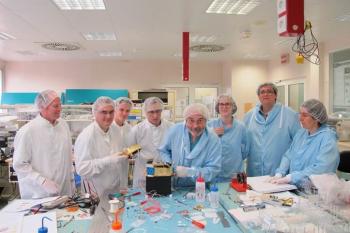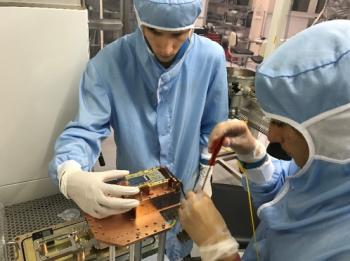A prototype of the MXT camera arrived at the CNES in Toulouse on 25 October 2018. This is the Structural and Thermal Model (STM), which will be integrated into the telescope that will be sent to China to be mounted on the SVOM satellite Qualification Model.
The objective of this model is to validate the thermo-mechanical design of the camera. It also makes it possible to check the manufacturing and assembly capacity of the various components, which represent more than 1,000 elements. The model realized includes all the camera subassemblies with a good level of representativeness of the flight model, both on its external design (interfaces with the telescope) and on its internal design (harnesses, connectors...). The electrical parts (detector, electronic boards, motor) are replaced by weights and heaters to simulate their mechanical and thermal behaviour.
X-ray photons were detected for the first time in late August 2018 with an engineering model of the SVOM MXT focal plane. This is an important step towards the validation of the design of the detection chain.
The MXT telescope, for Microchannel X-ray Telescope, will be flown on board the SVOM satellite, a collaborative project between France (CNES) and China (CAS, CNSA) to study gamma-ray bursts. It aims at detecting soft X-rays (0.2 to 10 keV) at during the early phases of the afterglow emission, and at providing an accurate (smaller than 1 arc minute) position of the burst. Irfu is in charge of the design and realization of the telescope camera, integrating a pnCCD (provided by MPE) X-ray imaging spectrometer assembled on a dedicated ceramic board. The flight model of the detector must be integrated into the camera in one year from now.



